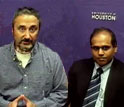News Release 09-211
Computer Science Provides a More Sound Way to Test for Sleep Apnea
New test less invasive, more comfortable way to diagnose this serious condition

Comparison of patient set-up and output in traditional sleep studies and thermal infrared imaging.
November 2, 2009
View a news briefing with Ioannis Pavlidis and Dr. Jayasimha N. Murthy.
This material is available primarily for archival purposes. Telephone numbers or other contact information may be out of date; please see current contact information at media contacts.
A computer scientist from the University of Houston and a doctor of sleep medicine at the University of Texas Health Science Center at Houston have teamed up to create a new, less invasive method of diagnosing sleep apnea. Their findings appear in the November issue of the journal Sleep.
Sleep apnea is serious disorder that causes a person to momentarily stop breathing while they sleep. These pauses in breathing can occur many times an hour, and can cause low oxygen levels in the blood and chronic sleepiness, which in turn can lead to deadly accidents. Sleep apnea has also been associated with a range of serious health problems including depression, heart disease and stroke.
Approximately 24 percent of men and 9 percent of women experience sleep apnea, but getting a diagnosis involves a procedure called polysomnography, also known as a sleep study. "It's not as simple as paying a visit to the doctor in the morning for an hour and walking away with a prescription," said Ioannis Pavlidis, Eckhard-Pfeiffer Professor of Computer Science at the University of Houston, and co-investigator of the study. "You have to undergo overnight monitoring in a sleep lab. The subject is wired and sleeps there. Sometimes, the subject has to spend more than one night."
Adding to the difficulty in getting a sleep apnea diagnosis is the invasive nature of current testing methods. "During a sleep study a subject has an average of more than 20 sensors attached to the head and body. It's a very complex procedure where many physiological parameters are simultaneously monitored to help in the diagnosis of sleep disorders. However, these sensors can disturb sleep and contribute to the patient's anxiety," said Jayasimha N. Murthy, assistant professor of medicine from the Division of Pulmonary Critical Care Sleep Medicine at UTHSC at Houston and study co-investigator.
The new diagnostic procedure developed by Pavlidis, Murthy and their collaborators uses a thermal infrared camera to monitor breathing waveforms and airflow as a patient breathes in and out of his or her nose. The measurements are processed using computational algorithms and produce results that have proved to be as accurate as traditional polysomnography. The new method also provides doctors with more information about the patient's breathing.
"In contrast to the traditional one-dimensional methods, this new method is an imaging one and thus, multi-dimensional," said Pavlidis. "We now can see how airflow is distributed locally throughout the extent of the nostril. We get not a single, but multiple values for each nostril at every point in time and this makes a lot of difference when it comes to appreciating subtle pathology."
The researchers believe that this new technology could change the way sleep apnea is diagnosed, potentially helping millions of Americans sleep better and possibly live longer.
-NSF-
-
View Video
Ioannis Pavlidis and Dr. Jayasimha N. Murthy discuss their new sleep apnea diagnosis tool.
Credit and Larger Version
Media Contacts
Dana W. Cruikshank, NSF, (703) 292-7738, email: dcruiksh@nsf.gov
The U.S. National Science Foundation propels the nation forward by advancing fundamental research in all fields of science and engineering. NSF supports research and people by providing facilities, instruments and funding to support their ingenuity and sustain the U.S. as a global leader in research and innovation. With a fiscal year 2023 budget of $9.5 billion, NSF funds reach all 50 states through grants to nearly 2,000 colleges, universities and institutions. Each year, NSF receives more than 40,000 competitive proposals and makes about 11,000 new awards. Those awards include support for cooperative research with industry, Arctic and Antarctic research and operations, and U.S. participation in international scientific efforts.
Connect with us online
NSF website: nsf.gov
NSF News: nsf.gov/news
For News Media: nsf.gov/news/newsroom
Statistics: nsf.gov/statistics/
Awards database: nsf.gov/awardsearch/
Follow us on social
Twitter: twitter.com/NSF
Facebook: facebook.com/US.NSF
Instagram: instagram.com/nsfgov



